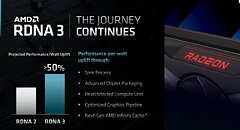- Joined
- Oct 9, 2007
- Messages
- 47,231 (7.55/day)
- Location
- Hyderabad, India
| System Name | RBMK-1000 |
|---|---|
| Processor | AMD Ryzen 7 5700G |
| Motherboard | ASUS ROG Strix B450-E Gaming |
| Cooling | DeepCool Gammax L240 V2 |
| Memory | 2x 8GB G.Skill Sniper X |
| Video Card(s) | Palit GeForce RTX 2080 SUPER GameRock |
| Storage | Western Digital Black NVMe 512GB |
| Display(s) | BenQ 1440p 60 Hz 27-inch |
| Case | Corsair Carbide 100R |
| Audio Device(s) | ASUS SupremeFX S1220A |
| Power Supply | Cooler Master MWE Gold 650W |
| Mouse | ASUS ROG Strix Impact |
| Keyboard | Gamdias Hermes E2 |
| Software | Windows 11 Pro |
AMD is planning to debut its next-generation RDNA3 graphics architecture with the Radeon RX 7000 series desktop graphics cards, some time in late-October or early-November, 2022. This, according to Greymon55, a reliable source with AMD and NVIDIA leaks. We had known about a late-2022 debut for AMD's next-gen graphics, but now we have a finer timeline.
AMD claims that RDNA3 will repeat the feat of over 50 percent generational performance/Watt gains that RDNA2 had over RDNA. The next-generation GPUs will be built on the TSMC N5 (5 nm EUV) silicon fabrication process, and debut a multi-chip module design similar to AMD's processors. The logic dies with the GPU's SIMD components will be built on the most advanced node, while the I/O and display/media accelerators will be located in separate dies that can make do on a slightly older node.

View at TechPowerUp Main Site | Source
AMD claims that RDNA3 will repeat the feat of over 50 percent generational performance/Watt gains that RDNA2 had over RDNA. The next-generation GPUs will be built on the TSMC N5 (5 nm EUV) silicon fabrication process, and debut a multi-chip module design similar to AMD's processors. The logic dies with the GPU's SIMD components will be built on the most advanced node, while the I/O and display/media accelerators will be located in separate dies that can make do on a slightly older node.

View at TechPowerUp Main Site | Source






 however, FSR 2.0 seems close to dlss.
however, FSR 2.0 seems close to dlss.